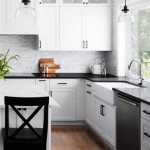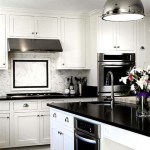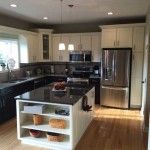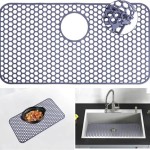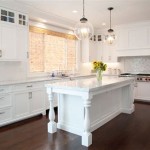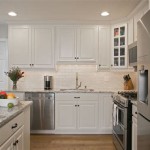What Color to Paint Kitchen Walls: A Comprehensive Guide
Selecting the optimal color for kitchen walls involves careful consideration of several factors beyond personal preference. The kitchen serves as a central hub in most homes, demanding a color palette that fosters a welcoming atmosphere while complementing the existing cabinetry, countertops, and flooring. This article provides a comprehensive guide to navigating the complexities of kitchen wall color selection, focusing on key aspects that contribute to a visually appealing and functional space.
Understanding the Impact of Color Psychology
Color psychology plays a significant role in how individuals perceive a space. Different colors evoke different emotions and can influence mood and appetite. Therefore, understanding the fundamental principles of color psychology is crucial for selecting a kitchen wall color that promotes a positive and inviting atmosphere.
Warm Colors:
Colors like red, orange, and yellow are often associated with energy, warmth, and stimulation. Red can stimulate appetite, but its intensity might be overwhelming for some. Orange is a more tempered option, often promoting comfort and communication. Yellow is cheerful and optimistic, but excessive use can lead to feelings of anxiety. In a kitchen, warm colors can create a cozy and inviting ambiance, particularly beneficial in larger spaces. However, it is advisable to use these colors as accents or in smaller kitchens to avoid overwhelming the space.Cool Colors:
Blue, green, and purple are considered cool colors and are generally associated with calmness, serenity, and relaxation. Blue can suppress appetite, making it a less conventional choice for kitchens. Green, on the other hand, is often associated with nature and freshness, making it a popular choice for kitchens. Purple, particularly lighter shades like lavender, can add a touch of elegance and sophistication. Cool colors can create a spacious and airy feel, especially beneficial in smaller kitchens. However, excessive use of cool colors can make a space feel cold or sterile.Neutral Colors:
Neutral colors such as white, gray, beige, and cream provide a versatile backdrop for any kitchen. White creates a clean and bright look, making it ideal for smaller kitchens or kitchens with limited natural light. Gray is a sophisticated and contemporary option that allows other elements in the kitchen to stand out. Beige and cream offer warmth and comfort, creating a welcoming atmosphere. Neutral colors are highly adaptable and can be easily paired with various accent colors and design styles.Considering Existing Kitchen Elements
The existing elements within the kitchen, such as cabinetry, countertops, flooring, and appliances, significantly influence the choice of wall color. The aim is to create a cohesive and harmonious design that complements these existing features. Failing to consider these elements can result in a disjointed and visually unappealing space.
Cabinetry:
The color of the kitchen cabinets is a primary factor to consider. White cabinets are highly versatile and can be paired with almost any wall color. Dark wood cabinets often look best with lighter wall colors to create a contrast and brighten the space. Painted cabinets offer more flexibility, but it is essential to choose a wall color that complements the specific paint color used on the cabinets. For instance, blue cabinets might pair well with light gray or white walls, while green cabinets might complement beige or cream walls.Countertops:
Countertop materials and colors also play a vital role. Granite countertops, with their varied patterns and colors, often require a neutral wall color to avoid clashing. Quartz countertops, available in a wide range of colors, offer more flexibility in terms of wall color selection. The undertones of the countertop should be considered when selecting a wall color. For example, countertops with warm undertones might pair well with warm-toned neutrals or muted warm colors.Flooring:
The color and material of the flooring should also be taken into account. Dark hardwood floors can ground the space and create a sense of warmth, while lighter tile floors can brighten the room. The wall color should complement the flooring and create a cohesive look. For instance, dark hardwood floors might pair well with lighter wall colors to create a contrast and visual interest.Appliances:
Stainless steel appliances are a common feature in many modern kitchens. These appliances tend to work well with a variety of wall colors, particularly neutral tones. Black appliances can create a bold statement and often pair well with lighter wall colors for a contrasting look. White appliances offer a clean and classic look and can be paired with a variety of wall colors, depending on the overall desired aesthetic.Evaluating Natural and Artificial Lighting
Lighting, both natural and artificial, significantly impacts how a color appears in a space. The amount of natural light a kitchen receives and the type of artificial lighting used can dramatically alter the perception of a wall color. Therefore, it is crucial to assess the lighting conditions before making a final decision.
Natural Light:
Kitchens with ample natural light can handle darker and more saturated colors without feeling cramped or gloomy. Natural light tends to enhance the vibrancy of colors, making them appear more true to their original hue. Conversely, kitchens with limited natural light require lighter and brighter colors to maximize the available light and create a more open and airy feel. Dark colors can absorb light, making a small or poorly lit kitchen feel even smaller and darker.Artificial Light:
The type of artificial lighting used in the kitchen also plays a crucial role. Incandescent lighting tends to cast a warm yellow glow, which can affect the appearance of wall colors. Fluorescent lighting tends to cast a cooler, bluish light, which can also alter the perception of colors. LED lighting offers a wide range of color temperatures, allowing for more control over the lighting environment. When selecting a wall color, it is essential to consider the type of artificial lighting used and how it will affect the color's appearance. Testing paint samples under different lighting conditions is highly recommended.Undertones and Light:
The undertones of a paint color can also be accentuated by different lighting conditions. For example, a white paint with a warm undertone might appear more yellow under incandescent lighting, while a white paint with a cool undertone might appear more blue under fluorescent lighting. It is important to understand the undertones of the paint color and how they will be affected by the existing lighting conditions.To accurately assess the impact of lighting, it is recommended to paint large swatches of the chosen colors on the walls and observe them throughout the day under different lighting conditions. This will provide a more realistic representation of how the colors will appear in the kitchen. Consider painting swatches in different areas of the kitchen to account for variations in lighting.
Popular Color Schemes and Trends
Staying informed about current color trends and popular color schemes can provide inspiration and guidance when selecting a kitchen wall color. While personal preference should always be a primary consideration, understanding current trends can help create a more modern and stylish kitchen.
All-White Kitchens:
All-white kitchens remain a timeless and popular choice. White walls, cabinets, and countertops create a clean, bright, and airy space. This scheme is particularly well-suited for smaller kitchens or kitchens with limited natural light. To add visual interest, consider incorporating different textures and materials, such as subway tile backsplashes or wood accents.Gray Kitchens:
Gray has become a popular neutral color for kitchens in recent years. Gray walls can create a sophisticated and contemporary atmosphere. Lighter shades of gray can create a spacious and airy feel, while darker shades of gray can add drama and depth. Gray pairs well with a variety of cabinet colors and materials, making it a versatile choice.Two-Tone Kitchens:
Two-tone kitchens, featuring cabinets in two different colors, are a growing trend. This allows for more customization and visual interest. For example, the upper cabinets might be painted white or a light color, while the lower cabinets are painted a darker color. The wall color should complement both cabinet colors and create a cohesive look.Earthy Tones:
Earthy tones, such as greens, browns, and beiges, are gaining popularity as homeowners seek to bring a sense of nature and tranquility into their homes. These colors can create a warm and inviting atmosphere in the kitchen. Green, in particular, is associated with freshness and vitality, making it a popular choice for kitchen walls.Bold Accent Walls:
Creating a focal point with a bold accent wall can add personality and visual interest to the kitchen. Choose a color you love and use it to paint one wall, such as the wall behind the stove or the wall opposite the entrance. The remaining walls should be painted a neutral color to balance the bold accent wall.Ultimately, the best color for kitchen walls is one that reflects personal style and creates a space that is both functional and visually appealing. By considering the principles of color psychology, the existing kitchen elements, the lighting conditions, and current color trends, a well-informed decision can be made that transforms the kitchen into a welcoming and stylish heart of the home.

Dulux Kitchen Paint Colours

What You Need To Know Before Painting Kitchen Walls Wren Kitchens

27 Kitchen Paint Color Ideas That Will Makeover Your For Walls Wall Design Trendy Colors

Dulux Kitchen Paint Colours

50 Best Kitchen Paint Colors And Color Combinations Hgtv

Kitchen Paint Colour Ideas Easy Design Indigo Paints

70 Top Kitchen Paint Colors Best 2024

40 Best Kitchen Paint And Wall Colors For 2024

What You Need To Know Before Painting Kitchen Walls Wren Kitchens

Easy Kitchen Color Ideas Colorfully Behr Blog


